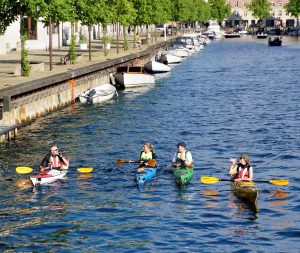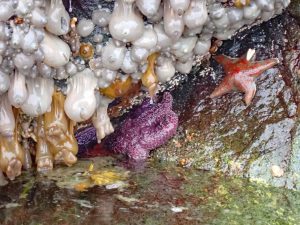Marine Trails Code of Conduct
Our Marine Trails Code of Conduct
Updated Jan. 29, 2021
The Marine Trail Code of Conduct is the culmination of four years of effort by BCMT involving consultations, research, peer review and public input. The Code was approved by the BCMT board on January 28, 2021, and will go through bi-annual reviews.
The Code of Conduct will be supported by a public education program to help people understand the intent, methods and implications of all aspects of the Code. Three versions exist: the short-form suitable for signs and quick reading, the long-form with additional information on the how and why of each subject covered in the short-form, and a pocket version for quick reference.


Code of Conduct Downloads
Want to learn more?
Check out these additional resources below. Select an element from the code of conduct to find additional information and links not found in the code documents.
Everywhere we paddle on the BC coast is the traditional territories of one or more of the 74 coastal First Nations. As paddlers we will inevitably transit through many different Nations territories. Part of our mandate is to work alongside First Nations to coordinate visitor access, current closures and visitor guidelines for their territories.
With 74 coastal First Nations up and down the BC coast, there is a complex network of different governances and different guidelines. As supplementary information to our Code of Conduct mandate on First Nations land visitation we have started to compile information that Nations have made public to assist in trip planning. Hopefully by utilizing this information we can have more respectful visitation in traditional territories across the coast.
As we work with Nations or discover public documentation for visitor guidelines, we will update the list below. Nations are in alphabetic order.
Ahousaht Nation
- Ahousaht Hahoulthee Current Closures
- The Ahousaht Stewardship Guardians are patrolling the water all summer long. Any recreation in the Ahousaht Hahoulthee requires a permit. Permits are $15/day/person. Permits are available at Paddle West Kayaking and Tofino Sea Kayaking offices in Tofino.
Haida Gwaii
- Visitors to Haida Gwaii are encouraged to sign a pledge to respect the islands and its people. Additionally you can find guidelines for respectful visitation and an understanding of the colonial impacts that face the Haida. Find the Haida Gwaii pledge here.
Kitasoo / Xai’xais Nation
Nanwakolas Council
Paddlers must consider their outdoor behaviours to reduce the impact on and interaction with different wildlife species. Below are links to Wild Safe BC documents that provide clear guidelines and considerations for each of the major wildlife species that paddlers can expect to encounter across the BC coast.
Terrestrial Wildlife
Marine Mammals
BC coastal waters have many invasive species. Being aware of the invasive species in our waters, paddlers can help contribute to citizen science by reporting what they find.
Don’t let invasive species hitch a ride on your watercraft or gear. Follow the BC invasive species directives below.
FAQ
BC Marine Trails (BCMT) wants to ensure minimal environmental impact by users at marine trail sites. Because sites are so widely dispersed and cannot have direct oversight, it is incumbent upon users to practice habits and behaviours that achieve minimal impact. By following the elements of this Code of Conduct, users can be assured their use of marine trail sites will lead to minimal environmental degradation.
BCMT wants people to adopt practices leading to environmental sustainability for recreational uses of the British Columbia coast. We need to shift some generally accepted behaviours and rethink our habits. By carefully considering the consequences of our behaviours, understanding the implications of what we do and the ways in which we need to change, all users understanding and voluntarily adhering to the Code, are acknowledging their role and responsibility as marine stewards.
There are obvious benefits to the environment, but it goes much deeper, and ultimately affects the public’s ability to access the coast. BCMT has been working diligently with landowners, First Nations, land managers, neighbourhood groups and other stakeholders to ensure access to locations for marine trail use and public recreation. If users are not respectful of these locations, these permissions might be revoked and made more difficult for BCMT to obtain in the future when new sites are needed. The Code is intended to be proactive rather than reactive to avoid issues before they arise. If unsuccessful, retroactive measures will be necessary to restore habitats and protect environmental features. The Code, if successful, means restricted and intensely managed camping locations shouldn’t be necessary.
Compliance to the Code is voluntary. Most best practices are based on the principle that site degradation is gradual and invisible, and so while your single use in violation of the Code may be of little to no consequence, it is the cumulative damage the Code is attempting to address. Nature has a threshold to absorb impacts, naturally, but since that limit cannot be measured or monitored in most cases, the best practice is to ensure your individual use cannot in any way contribute to the cumulative damage that can and does result. Notably, aspects such as trampling are shown to cause damage at low levels of use, and so the case for one person being of no significance does not necessarily apply. The Code’s recommended best practices are backed by scientific research, as laid out in the supporting documentation. BCMT will review the Code annually, so if you believe any element of the Code is flawed or requires review, please contribute to that process.
The Leave No Trace (LNT) principles are not designed for the British Columbia Coast or a marine environment in general. This means that principles that LNT uses may be suitable for alpine environments or along lengthy land trails, but are not the best practices for concentrated small-footprint coastal locations involving marine ecologies and sensitive nearshore terrestrial ecosystems. BCMT chose not to modify LNT principles but rather starts from scratch to address “subject areas” where recreational use would have impact. The BCMT approach was to research the underlying principles affecting those subject areas to establish best practices applicable to the BC coastal environment.
BCMT is acting on the principle that adverse effects, while inevitable, can be contained within a small and appropriate footprint, and largely minimized through proper use of the location. The BCMT goal is for sites to remain in as natural a state as possible. If users control wood burning, human waste, trampling and other behaviours that can lead to site degradation, as outlined in the Code, we can achieve that goal.
The Code is applicable to any coastal visit to a location outside of a managed or regulated structure, such as a provincial park, where the park rules would apply instead. This means hundreds of marine trail sites on Crown (public) land that have no formal designation and so are outside of any management, maintenance or oversight structure to ensure that site’s wellbeing. The Marine Trail Code of Conduct is meant to fill that gap through directing proper behaviour.
The Code is the general outline. BCMT will be supporting the Code with a robust Public Education Program to provide additional resources to help coastal visitors successfully implement the various aspects outlined in the Code. Please be patient — this is a huge project, and we have only just begun to tackle how to go about helping everyone rethink how to approach recreational use of the BC coast.
Related Posts
10 Tips to Boost Mental Health with Sea Kayaking and Nordic Friluftsliv
- Jerry Kaye
- May 3, 2024
- Coastal Journeys / Community / Conservation / Education / Trip Resources / Wildlife
Amazing Aquarium: The Intertidal Zone at Discovery Islands
- Lycette Clark
- April 26, 2024
- Coastal Journeys / Community / Conservation / Discoveries & Mid Coast / Education / Gulf Islands / Vancouver Island
What Happened When Covid Came Kayaking
- Fred Pishalski
- April 15, 2024
- Coastal Journeys / Education / Trip Resources / Vancouver Island
- 0 Comments


